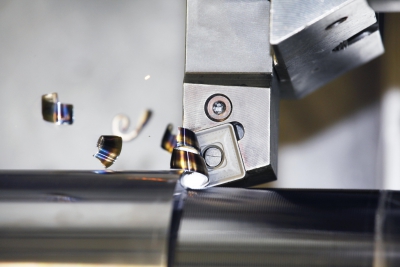Contact Details

Dormer Pramet has expanded its indexable offer for turning and milling applications.
Designed for rough forging and castings, the new Pramet HR2 chipbreaker features a positive, stable geometry for improved tool life and performance. The single-sided inserts are ideal for working in steels, cast irons and stainless steels. The HR2 delivers increased productivity with reliable chip formation and evacuation at high feeds.
The NMR chipbreaker is another addition to the range, a double-sided chip breakers specifically design for stainless steel operations. This new geometry joins the current double-sided range, which includes the NM (medium turning) and NF (finishing turning) chipbreakers.
The new W-FM and W-NM wiper inserts feature a positive front land for smooth machining. In straight turning and facing operations, the smoothing effect of the wiper results in improved quality of surface roughness. Single-sided positive inserts with the W-FM positive geometry are suitable for stainless steel and steels. The double-sided negative inserts with the W-NM highly positive geometry are ideal for machining stainless steel and low carbon steels.
The versatile T9226 is the newest grade and replaces the Pramet 6630 grade in heavy roughing and peeling operations. With reduced adhesion to the workpiece and greater cutting edge strength, the T9226 grade delivers operational reliability and longer tool life, according to the company.
The newest milling grade is the M6330, developed specifically to achieve longer cutting edge durability and reliability in a range of DTMM with and without coolant. Particularly suited to adverse cutting conditions, including interrupted cutting, the M6330 is available with many of Pramet's most popular inserts, including the ADMX, HNGX, LNGX, LNMU, OEHT and numerous other styles.
Related Glossary Terms
- carbon steels
carbon steels
Known as unalloyed steels and plain carbon steels. Contains, in addition to iron and carbon, manganese, phosphorus and sulfur. Characterized as low carbon, medium carbon, high carbon and free machining.
- cast irons
cast irons
Cast ferrous alloys containing carbon in excess of solubility in austenite that exists in the alloy at the eutectic temperature. Cast irons include gray cast iron, white cast iron, malleable cast iron and ductile, or nodular, cast iron. The word “cast” is often left out.
- chipbreaker
chipbreaker
Groove or other tool geometry that breaks chips into small fragments as they come off the workpiece. Designed to prevent chips from becoming so long that they are difficult to control, catch in turning parts and cause safety problems.
- coolant
coolant
Fluid that reduces temperature buildup at the tool/workpiece interface during machining. Normally takes the form of a liquid such as soluble or chemical mixtures (semisynthetic, synthetic) but can be pressurized air or other gas. Because of water’s ability to absorb great quantities of heat, it is widely used as a coolant and vehicle for various cutting compounds, with the water-to-compound ratio varying with the machining task. See cutting fluid; semisynthetic cutting fluid; soluble-oil cutting fluid; synthetic cutting fluid.
- gang cutting ( milling)
gang cutting ( milling)
Machining with several cutters mounted on a single arbor, generally for simultaneous cutting.
- land
land
Part of the tool body that remains after the flutes are cut.
- milling
milling
Machining operation in which metal or other material is removed by applying power to a rotating cutter. In vertical milling, the cutting tool is mounted vertically on the spindle. In horizontal milling, the cutting tool is mounted horizontally, either directly on the spindle or on an arbor. Horizontal milling is further broken down into conventional milling, where the cutter rotates opposite the direction of feed, or “up” into the workpiece; and climb milling, where the cutter rotates in the direction of feed, or “down” into the workpiece. Milling operations include plane or surface milling, endmilling, facemilling, angle milling, form milling and profiling.
- stainless steels
stainless steels
Stainless steels possess high strength, heat resistance, excellent workability and erosion resistance. Four general classes have been developed to cover a range of mechanical and physical properties for particular applications. The four classes are: the austenitic types of the chromium-nickel-manganese 200 series and the chromium-nickel 300 series; the martensitic types of the chromium, hardenable 400 series; the chromium, nonhardenable 400-series ferritic types; and the precipitation-hardening type of chromium-nickel alloys with additional elements that are hardenable by solution treating and aging.
- turning
turning
Workpiece is held in a chuck, mounted on a face plate or secured between centers and rotated while a cutting tool, normally a single-point tool, is fed into it along its periphery or across its end or face. Takes the form of straight turning (cutting along the periphery of the workpiece); taper turning (creating a taper); step turning (turning different-size diameters on the same work); chamfering (beveling an edge or shoulder); facing (cutting on an end); turning threads (usually external but can be internal); roughing (high-volume metal removal); and finishing (final light cuts). Performed on lathes, turning centers, chucking machines, automatic screw machines and similar machines.
- wiper
wiper
Metal-removing edge on the face of a cutter that travels in a plane perpendicular to the axis. It is the edge that sweeps the machined surface. The flat should be as wide as the feed per revolution of the cutter. This allows any given insert to wipe the entire workpiece surface and impart a fine surface finish at a high feed rate.





